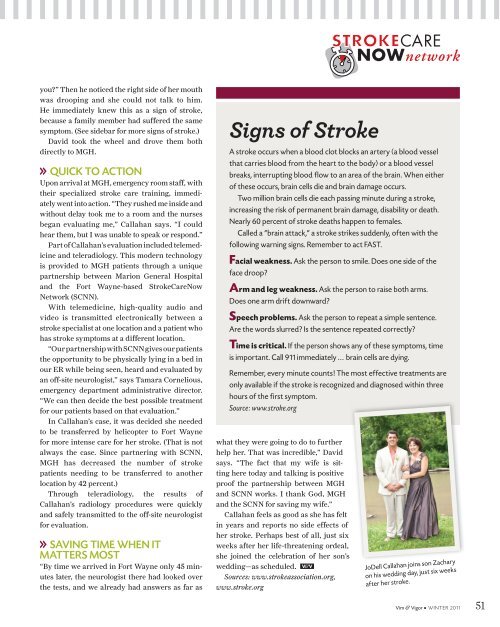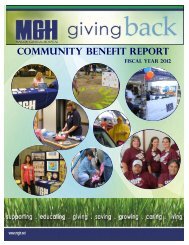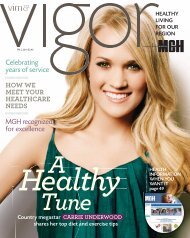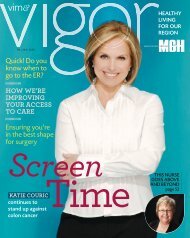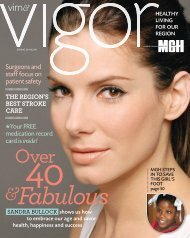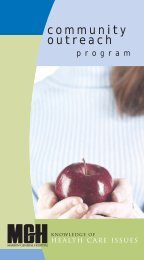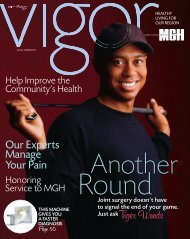With MGH - Marion General Hospital
With MGH - Marion General Hospital
With MGH - Marion General Hospital
Create successful ePaper yourself
Turn your PDF publications into a flip-book with our unique Google optimized e-Paper software.
you?” Then he noticed the right side of her mouth<br />
was drooping and she could not talk to him.<br />
He immediately knew this as a sign of stroke,<br />
because a family member had suffered the same<br />
symptom. (See sidebar for more signs of stroke.)<br />
David took the wheel and drove them both<br />
directly to <strong>MGH</strong>.<br />
QUICK TO ACTION<br />
Upon arrival at <strong>MGH</strong>, emergency room staff, with<br />
their specialized stroke care training, immediately<br />
went into action. “They rushed me inside and<br />
without delay took me to a room and the nurses<br />
began evaluating me,” Callahan says. “I could<br />
hear them, but I was unable to speak or respond.”<br />
Part of Callahan’s evaluation included telemedicine<br />
and teleradiology. This modern technology<br />
is provided to <strong>MGH</strong> patients through a unique<br />
partnership between <strong>Marion</strong> <strong>General</strong> <strong>Hospital</strong><br />
and the Fort Wayne-based StrokeCareNow<br />
Network (SCNN).<br />
<strong>With</strong> telemedicine, high-quality audio and<br />
video is transmitted electronically between a<br />
stroke specialist at one location and a patient who<br />
has stroke symptoms at a different location.<br />
“Our partnership with SCNN gives our patients<br />
the opportunity to be physically lying in a bed in<br />
our ER while being seen, heard and evaluated by<br />
an off-site neurologist,” says Tamara Cornelious,<br />
emergency department administrative director.<br />
“We can then decide the best possible treatment<br />
for our patients based on that evaluation.”<br />
In Callahan’s case, it was decided she needed<br />
to be transferred by helicopter to Fort Wayne<br />
for more intense care for her stroke. (That is not<br />
always the case. Since partnering with SCNN,<br />
<strong>MGH</strong> has decreased the number of stroke<br />
patients needing to be transferred to another<br />
location by 42 percent.)<br />
Through teleradiology, the results of<br />
Callahan’s radiology procedures were quickly<br />
and safely transmitted to the off-site neurologist<br />
for evaluation.<br />
SAVING TIME WHEN IT<br />
MATTERS MOST<br />
“By time we arrived in Fort Wayne only 45 minutes<br />
later, the neurologist there had looked over<br />
the tests, and we already had answers as far as<br />
Signs of Stroke<br />
A stroke occurs when a blood clot blocks an artery (a blood vessel<br />
that carries blood from the heart to the body) or a blood vessel<br />
breaks, interrupting blood flow to an area of the brain. When either<br />
of these occurs, brain cells die and brain damage occurs.<br />
Two million brain cells die each passing minute during a stroke,<br />
increasing the risk of permanent brain damage, disability or death.<br />
Nearly 60 percent of stroke deaths happen to females.<br />
Called a “brain attack,” a stroke strikes suddenly, often with the<br />
following warning signs. Remember to act FAST.<br />
Facial weakness. Ask the person to smile. Does one side of the<br />
face droop?<br />
Arm and leg weakness. Ask the person to raise both arms.<br />
Does one arm drift downward?<br />
Speech problems. Ask the person to repeat a simple sentence.<br />
Are the words slurred? Is the sentence repeated correctly?<br />
Time is critical. If the person shows any of these symptoms, time<br />
is important. Call 911 immediately . . . brain cells are dying.<br />
Remember, every minute counts! The most effective treatments are<br />
only available if the stroke is recognized and diagnosed within three<br />
hours of the first symptom.<br />
Source: www.stroke.org<br />
what they were going to do to further<br />
help her. That was incredible,” David<br />
says. “The fact that my wife is sitting<br />
here today and talking is positive<br />
proof the partnership between <strong>MGH</strong><br />
and SCNN works. I thank God, <strong>MGH</strong><br />
and the SCNN for saving my wife.”<br />
Callahan feels as good as she has felt<br />
in years and reports no side effects of<br />
her stroke. Perhaps best of all, just six<br />
weeks after her life-threatening ordeal,<br />
she joined the celebration of her son’s<br />
wedding—as scheduled.<br />
Sources: www.strokeassociation.org,<br />
www.stroke.org<br />
JoDell Callahan joins son Zachary<br />
on his wedding day, just six weeks<br />
after her stroke.<br />
Vim & Vigor · WINTER 2011 51


